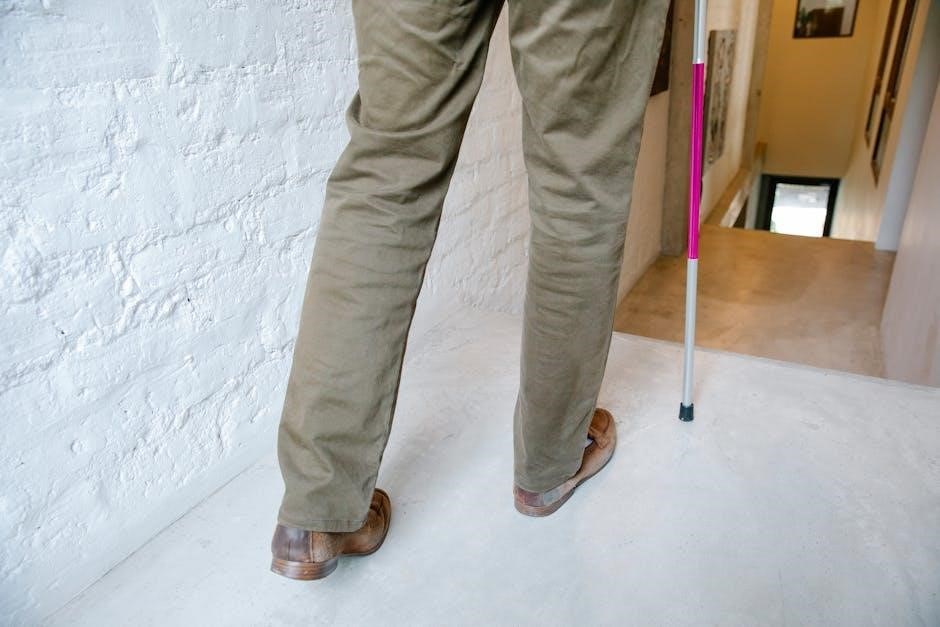Internalized homophobia refers to the subconscious adoption of homophobic beliefs‚ leading to self-shame and emotional distress. It stems from societal heterosexism and can hinder mental health and relationships. Understanding its roots is crucial for healing and fostering self-acceptance.
Defining Internalized Homophobia
Internalized homophobia is the process by which LGBTQ+ individuals unconsciously adopt and internalize societal homophobic messages‚ leading to self-shame‚ self-doubt‚ and emotional pain. It often arises from exposure to heterosexist norms‚ religious condemnation‚ or cultural stigma‚ which are then deeply ingrained in one’s psyche. This internalization can manifest as negative self-perceptions‚ denial of one’s true identity‚ or even self-loathing. It is a psychological response to external discrimination‚ causing individuals to struggle with self-acceptance and intimacy. Understanding this concept is vital for addressing its profound impact on mental health and relationships‚ as it forms the foundation for overcoming shame and achieving self-compassion.
The Impact of Societal Messages on LGBTQ+ Individuals
Societal messages perpetuate heterosexist norms‚ often marginalizing LGBTQ+ individuals and reinforcing internalized homophobia. These messages‚ transmitted through media‚ education‚ and cultural institutions‚ perpetuate stereotypes and stigma‚ leading to feelings of inadequacy and self-doubt. Constant exposure to homophobic rhetoric and the lack of representation can make individuals feel alienated and unworthy‚ internalizing these beliefs and struggling with self-acceptance. Such messages often isolate LGBTQ+ individuals‚ fostering a sense of disconnection from their true selves and their communities. Recognizing the pervasive influence of these societal narratives is essential to understanding their role in shaping internalized homophobia and to beginning the process of overcoming its harmful effects.
Why Understanding Internalized Homophobia Matters
Understanding internalized homophobia is crucial for addressing its pervasive effects on mental health and relationships. It sheds light on how societal heterosexism embeds harmful beliefs‚ leading to self-shame and emotional turmoil. Recognizing these patterns empowers individuals to challenge and overcome them‚ fostering self-acceptance and resilience. Without awareness‚ internalized homophobia can perpetuate cycles of self-doubt and isolation‚ hindering personal growth and community connection; By addressing its root causes‚ individuals and society can work toward healing and inclusivity‚ creating spaces where LGBTQ+ individuals thrive authentically. This understanding is vital for breaking free from shame and embracing a life of self-love and empowerment.

Understanding Internalized Homophobia
Internalized homophobia arises from societal heterosexism and homophobic messaging‚ leading to self-doubt‚ shame‚ and emotional turmoil. It profoundly impacts mental health and relationships‚ necessitating awareness and healing.
What Causes Internalized Homophobia?
Internalized homophobia stems from societal heterosexism and homophobic messaging‚ which perpetuate negative stereotypes about LGBTQ+ individuals. These messages‚ often ingested from family‚ religion‚ and media‚ foster self-doubt and shame. Growing up in environments where queer identities are demonized or erased can lead to the internalization of these harmful beliefs. Additionally‚ a lack of positive representation and constant exposure to discrimination contribute to feelings of inadequacy. Over time‚ these external messages become internalized‚ causing individuals to doubt their worth and struggle with self-acceptance. Understanding these root causes is essential for addressing and overcoming the deep-seated effects of internalized homophobia.
The Role of Heterosexism and Homophobic Messaging
Heterosexism‚ the belief in the superiority of heterosexuality‚ and homophobic messaging are central to the development of internalized homophobia. These societal forces perpetuate negative stereotypes‚ fostering an environment where LGBTQ+ individuals are shamed and marginalized. From religious teachings to media portrayals‚ homophobic messages are often internalized‚ leading to self-doubt and shame. Constant exposure to these harmful ideologies can make individuals view their own identities as flawed or unacceptable. This toxic environment reinforces self-hatred‚ making it difficult to embrace one’s true self. Recognizing the influence of heterosexism and homophobic messaging is vital to understanding how internalized homophobia takes root and persists.
How Internalized Homophobia Manifests in Daily Life
Internalized homophobia often manifests as self-monitoring behaviors‚ such as hiding one’s true identity or avoiding public displays of affection. It can lead to constant anxiety about being “outed” or judged‚ even in safe spaces. Many individuals struggle with self-shame‚ doubting their worthiness of love and acceptance. This can result in strained relationships‚ as fear of rejection or embarrassment creates emotional barriers. In some cases‚ it may cause avoidance of LGBTQ+ communities or events‚ further isolating individuals. These behaviors stem from deeply ingrained beliefs that being queer is unacceptable‚ highlighting the profound impact of internalized homophobia on daily life and mental well-being.

The Effects of Internalized Homophobia on Mental Health
Internalized homophobia can lead to severe mental health issues‚ including chronic anxiety‚ depression‚ and low self-esteem. It fosters self-hatred and isolation‚ profoundly affecting emotional well-being and relationships.
Shame and Self-Hatred: The Emotional Toll
Internalized homophobia often manifests as deep-seated shame and self-hatred‚ stemming from societal heterosexism and homophobic messaging. This emotional burden leads to self-criticism‚ self-doubt‚ and a distorted self-image. Individuals may feel unworthy of love or acceptance‚ struggling to reconcile their true identities with societal expectations. Shame can become internalized as a form of self-punishment‚ fostering a cycle of negativity. This emotional toll can impair mental health‚ relationships‚ and overall well-being‚ making it challenging to embrace authenticity. Addressing these feelings is crucial for healing and fostering self-acceptance.
Anxiety and Depression Linked to Internalized Homophobia
Internalized homophobia is closely tied to increased rates of anxiety and depression among LGBTQ+ individuals. The emotional burden of self-hatred and societal rejection creates chronic stress‚ leading to mental health struggles. Negative self-talk and feelings of inadequacy exacerbate these conditions‚ making it difficult to cope with daily life. The internal conflict between true identity and societal expectations fosters a cycle of emotional pain. Studies show that individuals grappling with internalized homophobia are more likely to experience severe anxiety and depressive episodes. Addressing these mental health challenges requires acknowledging the root causes and seeking supportive environments for healing and self-acceptance.
Low Self-Esteem and Its Consequences
Internalized homophobia often fosters deep-seated low self-esteem‚ as individuals may view themselves as flawed or unworthy due to societal stigma. This can lead to self-doubt‚ fear of rejection‚ and difficulty in forming healthy relationships. Low self-esteem may cause individuals to settle for unfulfilling partnerships or struggle with asserting their needs. It can also hinder personal growth and career aspirations‚ as self-worth is closely tied to one’s ability to pursue goals confidently. Additionally‚ low self-esteem can perpetuate a cycle of negativity‚ reinforcing harmful self-perceptions and making it harder to challenge internalized homophobic beliefs. Addressing self-esteem is essential for healing and reclaiming one’s identity.

Social Withdrawal and Isolation
Internalized homophobia can lead to social withdrawal and isolation‚ as individuals may feel ashamed to express their true selves or fear rejection from others. This isolation often stems from a deep-seated belief that they are unacceptable due to their sexual orientation. People may avoid forming close relationships‚ hide their identities‚ or disengage from social activities to protect themselves from potential judgment. Over time‚ this withdrawal can exacerbate feelings of loneliness and disconnection‚ further worsening mental health challenges like depression and anxiety. Breaking this cycle requires courage and support‚ as reconnecting with others and embracing one’s identity is a crucial step toward healing and self-acceptance.
Substance Abuse as a Coping Mechanism
Internalized homophobia often leads individuals to use substance abuse as a coping mechanism to escape feelings of shame‚ self-hatred‚ and emotional pain. Societal heterosexism and homophobic messaging can create a sense of unacceptability‚ driving people to self-medicate with drugs or alcohol. This behavior provides temporary relief but exacerbates underlying issues‚ further isolating individuals and worsening mental health. Substance abuse can also perpetuate a cycle of self-destruction‚ making it harder to address the root causes of internalized homophobia. Recognizing this pattern is crucial‚ as it highlights the need for professional support and healthier coping strategies to break free from both addiction and self-destructive thought patterns.
Strained Relationships and Intimacy Issues
Internalized homophobia often leads to strained relationships and intimacy issues‚ as individuals may struggle with feelings of unworthiness or fear of rejection. Societal messages of shame can create emotional barriers‚ making it difficult to trust others or form close connections. This fear of judgment can result in emotional distance or avoidance of intimate relationships‚ perpetuating a cycle of isolation. Such challenges can stem from the internalization of homophobic beliefs‚ which may cause individuals to doubt their own value or the validity of their feelings. These patterns can deeply impact mental health and self-esteem‚ highlighting the need for self-reflection and support to foster healthier relationships.

Recognizing Internalized Homophobia in Yourself
Recognizing internalized homophobia involves acknowledging negative self-talk‚ shame‚ and fear rooted in societal messages. Self-awareness is the first step toward healing and personal growth.
Signs and Symptoms of Internalized Homophobia
Signs of internalized homophobia include self-loathing‚ shame‚ and fear of being discovered as LGBTQ+. Individuals may experience anxiety‚ depression‚ or social withdrawal. Negative self-talk and difficulty accepting one’s identity are common. Some may avoid LGBTQ+ communities or struggle with intimacy. Others might overcompensate by conforming to heteronormative norms. These symptoms often stem from internalized societal messages and can deeply impact mental health and relationships. Recognizing these signs is crucial for seeking support and beginning the healing process.
Self-Reflection: Identifying Negative Self-Talk
Self-reflection involves examining your thoughts and beliefs to identify patterns of negative self-talk linked to internalized homophobia. This may include critical inner voices that diminish your worth or invalidate your identity. Pay attention to phrases that reflect self-shame or fear of judgment. Ask yourself if these thoughts align with your true values or if they stem from societal or cultural messaging. Recognizing these patterns is the first step toward challenging and reframe them. Journaling or mindfulness practices can help uncover deeply rooted beliefs and emotions‚ fostering a deeper understanding of how internalized homophobia manifests in your inner dialogue.
The Importance of Seeking Support
Seeking support is a vital step in overcoming internalized homophobia‚ as it provides a safe space to process emotions and challenge harmful beliefs. Connecting with understanding friends‚ support groups‚ or therapists can offer validation and guidance. Allies play a crucial role in creating an inclusive environment‚ helping to counteract societal heterosexism. Open conversations about internalized homophobia can empower individuals to embrace their identities and foster resilience. Building a network of compassionate individuals and communities is essential for healing and growth‚ allowing individuals to move beyond shame and self-hatred toward self-acceptance and empowerment.


Overcoming Internalized Homophobia
Overcoming internalized homophobia involves embracing self-acceptance‚ challenging harmful beliefs‚ and building resilience through support networks‚ therapy‚ and affirming practices‚ empowering individuals to move beyond shame and self-hatred.

The Power of Self-Compassion and Acceptance
Self-compassion and acceptance are vital in overcoming internalized homophobia. By practicing kindness toward oneself and acknowledging inherent worth‚ individuals can counteract the harmful effects of societal heterosexism. Self-compassion involves treating oneself with the same care and understanding one would offer a friend‚ fostering emotional resilience. Acceptance requires embracing one’s identity without judgment‚ recognizing its validity and beauty. This process helps dismantle internalized shame and fosters a healthier self-image. Mindfulness and self-kindness are powerful tools in this journey‚ allowing individuals to gradually release the burden of self-hatred. Embracing self-compassion and acceptance creates a foundation for healing and empowers individuals to live authentically‚ free from the weight of internalized homophobia.
Challenging Negative Beliefs and Thought Patterns
Challenging negative beliefs and thought patterns is essential to overcoming internalized homophobia. Many individuals internalize homophobic messages‚ leading to self-criticism and shame. Cognitive-behavioral techniques can help identify and reframe these harmful beliefs‚ replacing them with affirming and realistic ones. Self-reflection and journaling can also uncover deeply rooted negative thought patterns‚ allowing individuals to confront and challenge them. Surrounding oneself with supportive communities and allies further reinforces positive self-perceptions. By actively questioning and disputing internalized homophobic ideas‚ individuals can gradually dismantle these harmful narratives and cultivate a more compassionate and accepting mindset. This process is a cornerstone of healing and self-acceptance.
Building Self-Esteem Through Affirmative Practices
Building self-esteem is a vital step in overcoming internalized homophobia. Affirmative practices‚ such as daily affirmations and self-care rituals‚ help counteract negative self-perceptions. Engaging in activities that celebrate one’s identity fosters pride and confidence. Surrounding oneself with supportive‚ affirming communities and role models can also enhance self-worth. Techniques like mirror work‚ where individuals practice positive self-talk‚ and grounding exercises‚ which reinforce self-acceptance‚ are effective tools. By consistently reinforcing positive beliefs‚ individuals can gradually dismantle internalized shame and replace it with self-compassion and empowerment. These practices not only improve mental health but also create a foundation for lasting self-love and resilience.

The Role of Therapy in Healing
Therapy plays a crucial role in healing from internalized homophobia by providing a safe space to explore and challenge deeply ingrained negative beliefs; Trained therapists can help individuals identify and reframe harmful thought patterns rooted in societal heterosexism. Cognitive-behavioral techniques‚ mindfulness practices‚ and emotionally focused interventions are often used to address self-shame and foster self-compassion. Therapy also offers tools to develop healthy coping mechanisms and rebuild self-esteem. Working with a therapist who specializes in LGBTQ+ issues ensures a supportive and non-judgmental environment‚ empowering individuals to embrace their authentic selves and move toward lasting healing and self-acceptance. Professional guidance is key to navigating this transformative journey effectively.
Finding Support Networks and Communities
Finding supportive networks and communities is essential for overcoming internalized homophobia. Connecting with others who share similar experiences fosters understanding and validation‚ helping individuals break free from isolation. LGBTQ+ support groups‚ both online and in-person‚ provide safe spaces to express emotions and challenges. Community centers and organizations often offer resources‚ workshops‚ and events tailored to healing and empowerment. Engaging with affirming communities helps counteract harmful societal messages and rebuild self-worth. Additionally‚ allies who actively support LGBTQ+ individuals play a vital role in creating inclusive environments. Building a strong support system is a powerful step toward embracing one’s true identity and living authentically.
Embracing Your True Identity
Embracing your true identity is a cornerstone of overcoming internalized homophobia. It involves acknowledging and accepting your authentic self‚ free from the influence of harmful societal norms. This journey often begins with self-reflection‚ recognizing the deeply ingrained beliefs that have led to self-shame. By challenging these beliefs and replacing them with affirming thoughts‚ individuals can gradually embrace their sexuality or gender identity. Surrounding oneself with supportive communities and role models who celebrate diversity can further reinforce this acceptance. Embracing one’s true identity not only fosters personal liberation but also empowers individuals to live authentically‚ contributing to a more inclusive and compassionate society.
Setting Boundaries with Homophobic Environments
Setting boundaries with homophobic environments is essential for protecting your mental and emotional well-being. This may involve limiting contact with individuals or spaces that perpetuate harmful stereotypes or beliefs. Establishing these boundaries requires self-awareness and a commitment to prioritizing your own needs. It’s important to communicate your limits clearly and assertively‚ even if it means distancing yourself from certain relationships or communities. By doing so‚ you create a safer space for self-expression and reduce the influence of negative external messages. Over time‚ these boundaries can help diminish the impact of internalized homophobia and foster a more positive sense of self.
The Role of Allies in the Journey to Self-Acceptance
Allies play a vital role in supporting LGBTQ+ individuals overcome internalized homophobia. Their acceptance and advocacy create safe spaces for self-expression and validation. Allies can challenge homophobic narratives and promote inclusivity‚ helping to counteract harmful societal messages. By actively listening‚ educating themselves‚ and standing against discrimination‚ allies empower individuals to embrace their true identities. Their unwavering support fosters resilience and self-acceptance‚ aiding in the healing process from internalized shame. Allies’ involvement is crucial in dismantling heterosexism and fostering a culture of acceptance‚ enabling LGBTQ+ individuals to thrive authentically without fear of judgment or rejection.

Overcoming internalized homophobia is a journey of self-discovery‚ healing‚ and empowerment. Embracing one’s identity and seeking support fosters resilience‚ allowing individuals to thrive authentically and find true self-acceptance.
The Journey to Self-Love and Acceptance
The journey to self-love and acceptance involves recognizing and challenging internalized homophobic beliefs; It requires self-compassion‚ education‚ and support networks to replace shame with pride. Through therapy‚ community connections‚ and affirming practices‚ individuals can heal and embrace their true identities. This empowerment fosters resilience‚ enabling them to thrive authentically and live fulfilling lives free from self-hatred.
Empowerment Through Knowledge and Action
Empowerment begins with understanding the roots of internalized homophobia and actively challenging harmful beliefs. By educating oneself about LGBTQ+ rights and histories‚ individuals can dismantle ingrained shame. Taking actionable steps‚ such as setting boundaries with homophobic environments and engaging in advocacy‚ fosters personal growth. Allies play a crucial role by amplifying marginalized voices and creating inclusive spaces. This collective effort promotes resilience and self-worth‚ helping individuals move beyond self-hatred toward authentic self-expression and confidence. Knowledge and action empower individuals to reclaim their identities and live unapologetically‚ paving the way for a more inclusive and affirming society for all.
Resources for Further Growth and Healing
Accessing the right resources is vital for healing from internalized homophobia. Support groups‚ such as PFLAG or local LGBTQ+ community centers‚ provide safe spaces for sharing experiences. Therapists specializing in LGBTQ+ issues can offer tailored guidance. Books like The Velvet Rage and Internalized Homophobia provide insightful perspectives. Online forums and hotlines‚ like The Trevor Project‚ offer immediate support. Engaging in affirming spiritual practices and connecting with inclusive communities can also foster growth. Additionally‚ workshops on self-compassion and boundary-setting empower individuals to reclaim their identities. These resources collectively provide tools for overcoming shame and embracing authenticity.